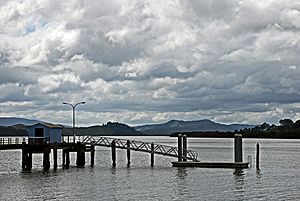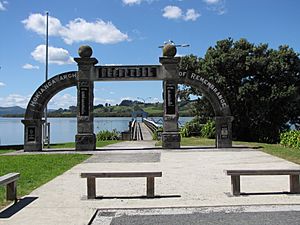Kohukohu, New Zealand facts for kids
Quick facts for kids
Kohukohu
|
|
|---|---|

Kohukohu Wharf
|
|
| Country | New Zealand |
| Region | Northland Region |
| District | Far North District |
| Ward | Kaikohe/Hokianga |
| Area | |
| • Total | 4.26 km2 (1.64 sq mi) |
| Population
(2018 Census)
|
|
| • Total | 168 |
| • Density | 39.44/km2 (102.1/sq mi) |
Kohukohu is a village on the Hokianga Harbour in the Northland Region of New Zealand. It was one of the first European settlements in New Zealand.
Kohukohu is situated on the northern shore of the harbour where it splits into two rivers, the Mangamuka River branching inland to the northeast and the Waihou River leading towards the east past Mangungu, Horeke and Rangiahua.
Where the harbour divides there is a small island called Motiti which was painted by Augustus Earle, the first European artist to spend several months in New Zealand, during his visit to the Hokianga in 1827. He wrote "we were sailing up a spacious sheet of water, which became considerably wider after entering it; while majestic hills rose on each side .... looking up the river we beheld various headlands stretching into the water and gradually contracting its width, 'till they became fainter and fainter in the distance and all was lost in the azure of the horizon".
Early history
According to Te Tai Tokerau tradition, the legendary Polynesian explorer, Kupe visited the area in 925 AD prior to his return voyage to Hawaiiki. Angry at the food from the hangi (earth oven) being insufficiently cooked, he cursed those responsible using the word kohu. Hence Kohukohu.
The first recorded European to enter the Hokianga Harbour arrived in 1819 and by the 1830s, Kohukohu was the heart of New Zealand's timber industry. The country's first Catholic mass was celebrated 8 kilometres north of Kohukohu at Totara Point in 1838.
For nearly one hundred years Kohukohu was an important timber milling town and the largest commercial centre on the north of the harbour. In 1900, the township had a population of almost 2,000 people.
Kohukohu Today
Today, Kohukohu is a community of 150 people who live within the village and approximately 350 who live in the surrounding area. The smaller settlements of Tauteihiihi, Motukaraka, Pikiparia, Te Karae, Mata, and Paponga are very close by. Kohukohu has a school, general store, café, art galleries, arts and crafts shop, hotel, voluntary fire and ambulance services, and a health clinic. There are also two churches and three Marae within the locality.
The Kohukohu footbridge in the centre of the town was built of Sydney sandstone some time in the 1840s, was the first stone bridge in the country, and is the oldest bridge of any construction still in existence in New Zealand. It was sited at the mouth of the Waihouuru Creek where it flowed into the Hokianga Harbour at that time. The harbour foreshore is today about 100 meters from the bridge.
In recent years, Kohukohu has become an increasingly popular destination for travellers who are attracted by its beautiful scenery, history, culture and arts. There are a number of accommodation options available locally; including backpackers, cottages, and bed & breakfast facilities.
Demographics
Statistics New Zealand describes Kohukohu as a rural settlement. It covers 4.26 km2 (1.64 sq mi). Kohukohu is part of the larger Kohukohu-Broadwood statistical area.
| Historical population | ||
|---|---|---|
| Year | Pop. | ±% p.a. |
| 2006 | 186 | — |
| 2013 | 168 | −1.44% |
| 2018 | 168 | +0.00% |
Kohukohu had a population of 168 at the 2018 New Zealand census, unchanged since the 2013 census, and a decrease of 18 people (−9.7%) since the 2006 census. There were 81 households, comprising 78 males and 90 females, giving a sex ratio of 0.87 males per female. The median age was 58.0 years (compared with 37.4 years nationally), with 24 people (14.3%) aged under 15 years, 21 (12.5%) aged 15 to 29, 72 (42.9%) aged 30 to 64, and 54 (32.1%) aged 65 or older.
Ethnicities were 75.0% European/Pākehā, 37.5% Māori, 1.8% Pacific peoples, and 3.6% Asian. People may identify with more than one ethnicity.
Of those people who chose to answer the census's question about religious affiliation, 50.0% had no religion, 32.1% were Christian and 1.8% had other religions.
Of those at least 15 years old, 39 (27.1%) people had a bachelor's or higher degree, and 27 (18.8%) people had no formal qualifications. The median income was $19,500, compared with $31,800 nationally. 9 people (6.2%) earned over $70,000 compared to 17.2% nationally. The employment status of those at least 15 was that 33 (22.9%) people were employed full-time, 21 (14.6%) were part-time, and 9 (6.2%) were unemployed.
Education
Kohukohu School is a co-educational full primary (years 1-8) school with a roll of 35 students as of April 2023. The school was established in 1883, but moved to a new location in 1972 because the ground on the original site was unstable. The original site with the original school building is now a historic reserve.
Notable people
- James Fisher-Harris, rugby league player for the Penrith Panthers
Images for kids
-
Kohukohu in 1918. On the foreshore are the Kohukohu Hotel, the Bank of New Zealand, D B Wallace Store, Laslett's Cash Store, and W L Sargeant (machinist)






